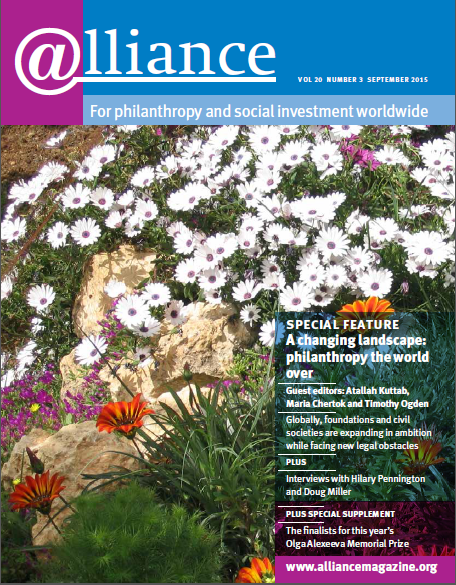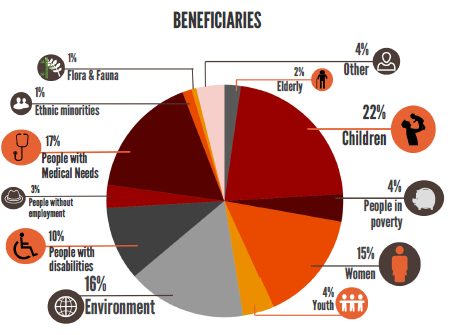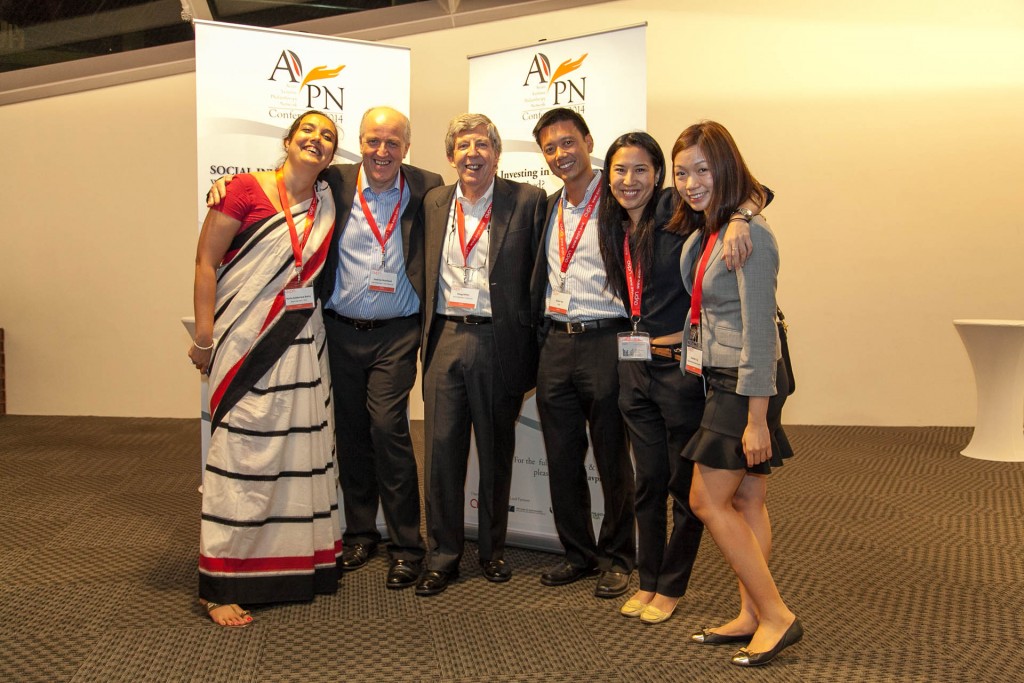Ten years ago Doug Miller and four of his private equity industry colleagues founded the European Venture Philanthropy Association (EVPA) to stimulate the growth of venture philanthropy in Europe. Three years ago, he created the Asian Venture Philanthropy Network (AVPN), which now has more than 220 members in 29 countries. While lessons learned from the European experience contributed to AVPN’s success in Asia, philanthropy is substantially different on the two continents. What are the differences and how is AVPN dealing with them? What does the future hold for venture philanthropy in Asia? He talks here with Caroline Hartnell.
What do you see as the big differences between philanthropy and venture philanthropy?
Venture philanthropy (VP) is a subset of philanthropy. It focuses on key principles of long-term funding and capacity building directed towards the goal of building strong, sustainable organizations able to generate significant social impact. We bring in skilled volunteers from the professional and business sectors to work with management on a wide range of challenges, including hiring additional human resources, bringing in information technology systems, defining outcomes and performance measurement, and possibly even evolving the business model.
We view the teams we’re dealing with as true partners. Coming from the private equity industry, we know that the value isn’t actually produced by our capital, but by the management teams we back. Collaboration and joint funding from a variety of sources are encouraged, as that brings in more experts and supporting networks.
‘Coming from the private equity industry, we know that the value isn’t actually produced by our capital, but by the management teams we back.’
VP has expanded. It’s not just a subset of grantmaking philanthropy, but includes the greater spectrum of social investment. How does that fit your principles?
Every one of the principles stated above applies just as much to social enterprises with earned revenue models as to charities. In fact, our private equity experience with revenue generation offers additional benefit to social enterprises. If you invest in social enterprises and they succeed, they become cashflow positive through income earned, and therefore more scalable and sustainable because the chief executive is able to spend more time on growing and improving the business. However, I believe philanthropists and social investors should work more closely together, as in the early days, almost all social enterprises are cashflow negative and need philanthropic support.
Did the lessons learned from setting up EVPA contribute to the rapid success of AVPN?
We used the EVPA success to show the Asian market what was possible. It also taught us the importance of targeted marketing to the seven different silos – foundations, family offices, private-equity and hedge-fund professionals, corporations, professional service firms, universities, and government-related organizations. We’ve been helped by advances in social media and by our ability to bring over European and US participants to demonstrate successful models.
How might your marketing approach to, say, foundations differ from that to family offices?
Our approaches are similar. Because we have a small staff, we are always looking for consolidators – instead of approaching 50 foundations individually, we went through the European Foundation Centre in Brussels and the Association of Charitable Foundations in the UK. We worked the same way to attract family offices; we established relationships with banks like JP Morgan, UBS, HSBC and Credit Suisse. Today we work with over 15 private banks and we’re always looking for more opportunities.
What about in Asia? Are there consolidators for foundations?
There aren’t that many local foundations in Asia. In India, we go straight to the top foundations and use our EVPA experience to get a meeting. In Hong Kong, there are a few foundations, and we can reach them directly. Japan has an association of foundations, but we have the Nippon Foundation as a partner, which is by far the biggest Japanese foundation. In China we have a strong relationship with the China Foundation Center, which has almost 4,000 members. We also engage with many of the big US and European foundations that are active in Asia.
What differences do you notice in attitudes to VP in Asia compared with Europe?
There is immediate buy-in to the advantage of using business methods to address social issues in Asia because most of the foundations and family offices are younger. Another big difference is there is no concept of being ‘Asian’. The Indian, Chinese and Japanese civilizations are quite separate; and the Thais are hugely different from the Malays and Vietnamese. Each market needs a tailored approach that recognizes the cultural differences.
But you describe yourself as the Asian Venture Philanthropy Network?
Despite the differences, there is still much that countries in Asia share. In addition to geographical proximity and history, similar social problems exist in all of those countries, although the way to address them might be different because of culture or legislation.
The distinguishing characteristic in Asia is openness to adopting other ideas and a bias for action, as happened with the manufacture of cars and electrical goods. We recently brought 20 government officials and advisers over to Europe, sponsored by the BMW Foundation, and they were massively impressed by what was happening. Five out of the seven governments that participated are already putting into practice programmes they learned about, which was quicker than even our most optimistic estimates. A subsequent event attracted three more governments, and we recently had a meeting with the Asian Development Bank, which has 66 governments as members. The bank has a small division concerned with social issues and is eager to explore a programme with us that would leverage their convening power to share our content.
How is VP developing in different parts of the region?
We think the potential across Asia is huge – lots of new as well as existing wealth would flow into the social sector if there was more transparency and if people thought the money was being used effectively. Similarly, there are hundreds of thousands of people who are willing to provide support on the human capital side through professional service firms and corporate CSR programmes. AVPN can also bring in intellectual capital (the business models practised effectively in other countries), which could be adapted for Asian countries. However, each country will develop differently and at its own pace.
How does this localization work?
When setting up AVPN, we realized that because India and China are so huge they would need separate organizations. In India, we’ve been working to establish a new entity that will evolve into the Indian Venture Philanthropy Association, with AVPN serving as a strategic partner, a content provider and a connector to other parts of the world.
And China?
We have similar plans for China. We have 27 members in mainland China, 26 members in Hong Kong, increasing interest in Taiwan, and a number of global organizations that are interested in deploying funds across China. The challenge in China is that the government is very concerned about how the social sector is organized and developed. At the moment, it doesn’t look feasible for us to establish a direct operation, so we’re establishing strategic partnerships with four to five prominent Chinese groups.
How important is impact investing compared to VP?
There’s a lot of interest in Asia in impact investing, but deal flow is extremely limited and there are few examples of success. I think a number of key questions on impact investing still need to be answered: tensions between social and financial return; what are the realistic prospects of exiting? do you really want to exit? I think impact investing will continue to develop, but probably not at the rate that some of its proponents anticipate.
Could you expand a little on what you said about tensions?
There’s a tension between running a business, which demands a profit and almost always has financial ups and downs, particularly in its early years, and producing specific social returns which may reduce profits, at least in the short term. Investors need to be clear about the balance of financial and social objectives and risk tolerance. It’s not that the tension can’t be resolved; it’s just that both opportunities and challenges need to be highlighted, and people need to address issues openly.
Also, if you’re going to have a return on investors’ money you have to work out how you’re going to exit and I don’t believe there’s been enough discussion about that. If you’re a pension-fund adviser or an insurance company, a return on and of investors’ money needs to be your highest priority, while still focusing on the social return. If foundations are using their grant money, they can focus exclusively on creating social impact. If they’re using their endowment, then they are anticipating a financial return and need to define any trade-offs. Government could have a role in protecting some of the downside risks through a carefully constructed programme to promote innovation and scaling. Additionally, private investors may be prepared to absorb more risk.
‘In the social sector, winners are not going to produce a tenfold return, so early‑stage innovation probably needs to be funded by foundations, high net worth families or governments, who are not dependent on getting that return.’
In the venture capital industry, often 50 per cent of companies fail, and others are only marginally successful, but the winners produce such a high return that you can achieve an overall decent return on your portfolio. In the social sector, winners are not going to produce a tenfold return, so early-stage innovation probably needs to be funded by foundations, high net worth families or governments, who are not dependent on getting that return.
What do you see as the barriers to further development of VP in Asia?
It varies from country to country. People buy into the VP concept immediately, but understanding and sophistication of practice are slower to develop. Governments are increasingly positive and we’re promoting tri-sector collaboration. We have recently issued the guide Getting started in venture philanthropy in Asia, while EVPA has issued a new report called Corporate social impact strategies: New paths for collaborative growth. We intend to get engagement around both of these topics by holding Asian workshops and round tables, and featuring them at our annual conference.
What are the next steps for AVPN?
We expect to have well over 250 members by this time next year. We are working hard on developing more depth to our membership services, particularly in education and collaboration. Our Knowledge Centre is critical here. Promoting cross-border learning and developing formal programmes for cross-border replication of successful models are hugely important projects. Discussions to catalyse new VP or social investment funds in China, Thailand, Malaysia, Australia and India are progressing with considerable local interest.
What are the next steps regionally and perhaps globally?
From day one, the plan was to roll out the VP model globally, but to do it through regional membership organizations that were closer to the market and controlled and directed by regional boards of directors. Getting acceptance of the key concepts of VP was a wider goal, even if people did not become active venture philanthropists. EVPA has made that transition and has an all-European board. AVPN has 10 board members, of which two are non-Asian.
Longer term, we plan to set up the International Venture Philanthropy Centre (IVPC), an umbrella organization that will accelerate the growth of new associations in Africa, Latin America and the Middle East. Each rollout is a massive task and requires learning about each of the markets – opportunities and obstacles, how we could add value, identifying local partners, organizing the finance, and identifying potential early adopters. We have great experience and credibility from EVPA and AVPN. IVPC will also execute broader goals around knowledge sharing, training and building global relationships. We’re in the early stages with IVPC, but plans are progressing well – watch this space.
For more information
http://www.avpn.asia
http://evpa.eu.com









Comments (0)